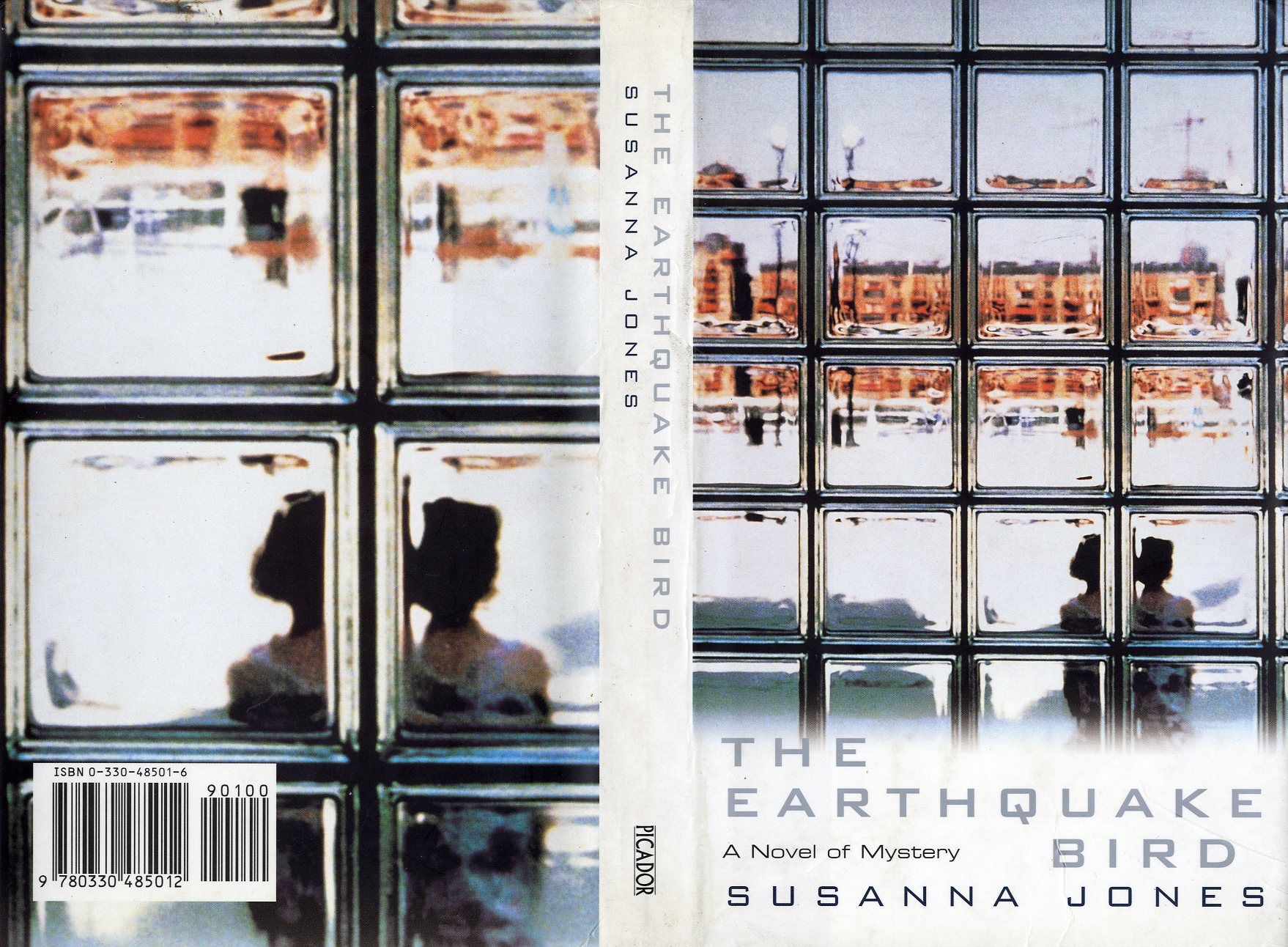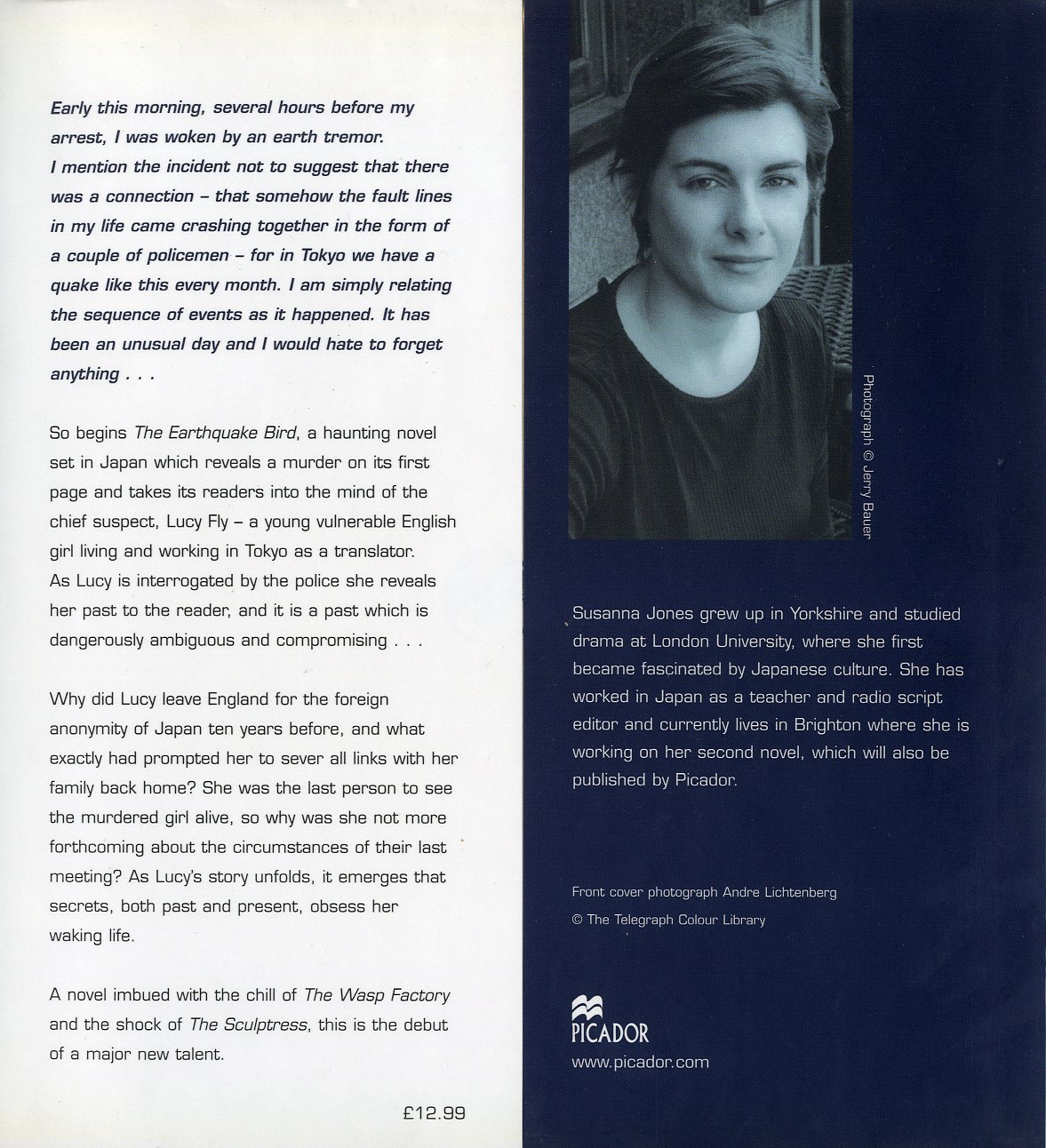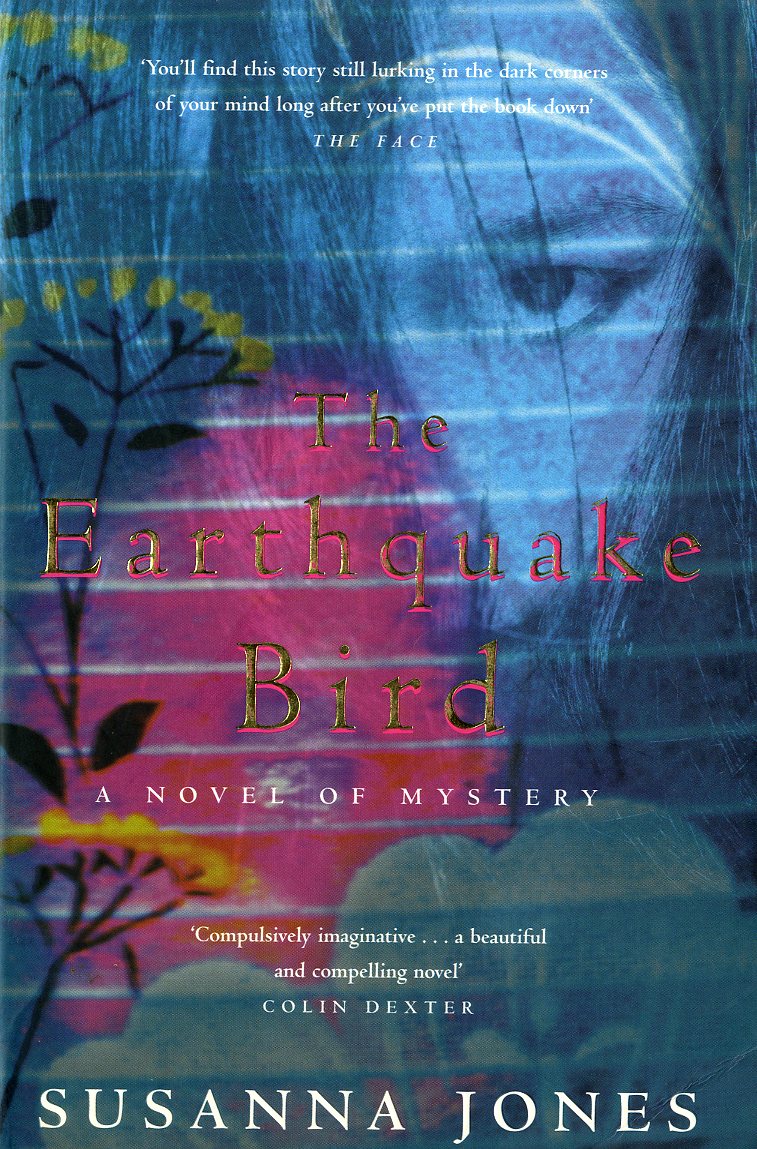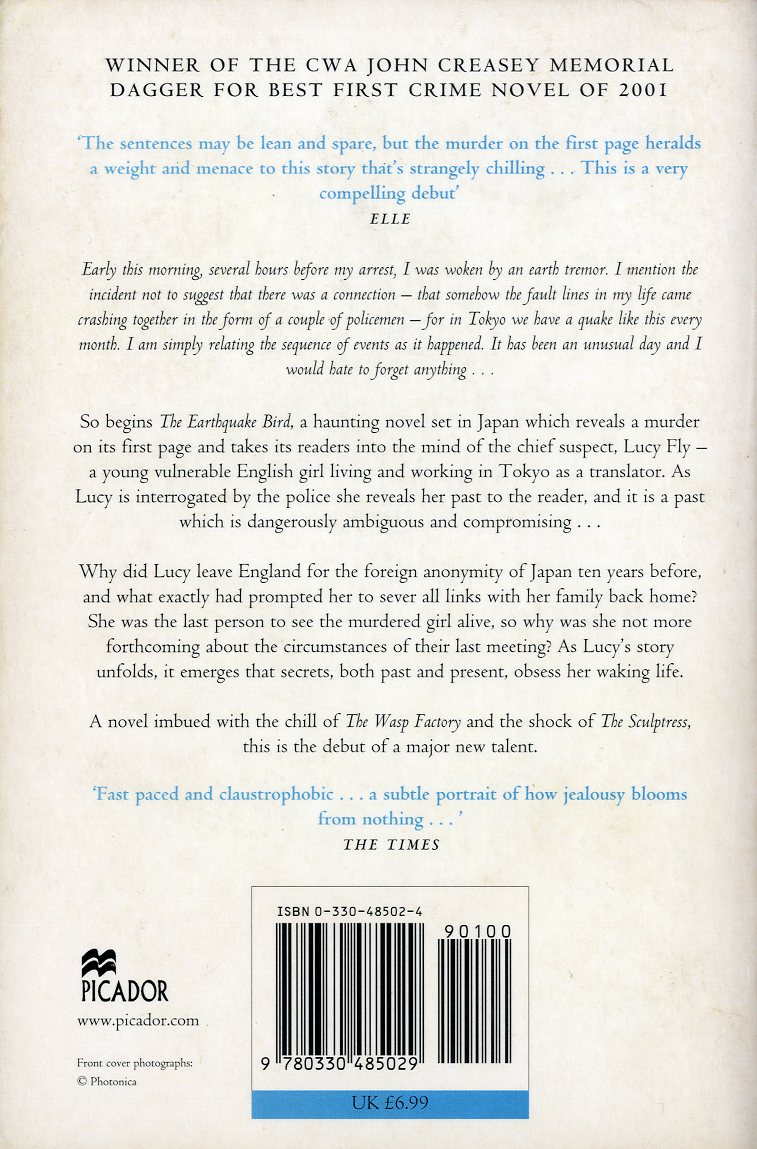The Earthquake Bird
"for now I'll be the murderer"
By William Wetherall
First posted 11 August 2024
Last updated 13 August 2024
Susanna Jones 2001, 2019The Earthquake BirdThis story, involveing the disappearance and apparent murder of a British woman in Japan, and the police investigation of her best friend, another British woman in Japan, is linked from Backpackers, sojourners, settlers page. Partly due to the impact of the 2019 film adaptation of The Earthquake Bird, the 2001 novel has been published in numerous languages, and in a new 2019 tie-in edit. English editionsSusanna Jones Japanese translationXUi W[Y () Suzanna Joonzu (Susanna Jones) (author) Chinese translationhXP ąłz (Susanna Jones) Korean translation수재나 존스 (Susanna Jones) European translationsDove la terra trema Wo die Erde bebt L'Oiseau-tempête La musica del terremoto Jordskalvs fågeln Proof copyAn uncorrected proof copy offered for sale by an used book dealer devotes the front cover to an attractive photo of the author. A blub on the cover bills the novel "A crime debut as chilling as The Wasp Factory and as shocking as The Sculptress" -- publicity bumped to the back of the first paperback edition. Having read neither of these chilling and shocking novels, I can only say that I didn't find The Earthquake Bird particularly chilling or shocking. Several decades of observing the human condition, in real life and fiction, have taught me that the depths of human psychological and social pathology unfathomable. That being said, how can a reader possibly be chilled or shocked by something after being told one will be? The storyA body believed to be that of Lucy Fly's missing friend Lily Bridges is found in Tokyo Bay. Police conclude they need to interrogate Lucy as the last person who seems to have seen Lucy alive. Two officers escort Lucy from her place of work to a police station, where a detective interrogates here. Lucy, who is narrating her own story, plays cat and mouse with the police -- telling the reader she is fluent in Japanese, but letting the police think she needs an interpreter -- until the interrogator, through the interpreter, extracts from her the truth of the matter (page 7, hardcover edition) 'And you work in Tokyo, in Shibuya,' the old, fat policeman says in Japanese. When it's relayed into English, I reply, 'That's right.' As I read this, I kept wondering whether readers would get off on Lucy's attitude toward the police, given her situation. The entire story unfolds like this. Lucy knows everything about her own past and recent circumstances. But she seems to think that the police are not very bright, as they have brought her in from questioning from her place of work as a translator of Japanese to English -- yet assume that she, being a foreign in Japan, though for 10 years, can't speak Japanese, or at least not well enough for the purposes questioning her about Lily disappearance and apparent murder. Lucy makes the job of the police -- and her own position -- as difficult as possible by limiting her revelations only to matters they directly inquire about. Rather than help the police understand who she is, if only to eliminate herself from the top of their list of suspects, she strings both the police and readers along -- until it conveniences her psychological-thriller plot to reveal more. The police case against Lucy is based entirely on circumstancial evidence -- which of course Lucy understands, as she protests her innocence to the police. But she also leaves readers puzzled -- though, of course, to keep readers a bit off balance is the whole purpose of writing a novel like this. Not until the second to last of the novel's 15 chapters, written in sparkling prose, does hard evidence surface that Lucy could not have killed her friend -- despite the fact that she appears to have had both a strong motive and ample opportunity. Lucy confides in the reader -- "No, I didn't kill Lily. Lucy is innocent of murder and guilty only of spinning a story." Yet she continues to toy with the reader, as she wonders "how innocent am I? How not guilty?" -- and imgines herself, if prosecuted, entering a plea like this (page 202). Not guilty, but how not guilty. Not entirely guilty but not entirely innocent. The truth may [come] out in the trial, but for now I'll be the murderer. As literatureThe authors of most "Japan novels" written in English seem to feel obliged to teach readers about Japan. Thankfully, Jones suppresses, better than writers of most such fiction, the urge to explain things Japanese. There are comparatively few language lessons like "pera pera / fluently". Jones gives several paragraphs to a bathing scene at a hotsprings, in which she describes how to take a communal bath. But there are fewer such tourguide-esque asides than I expected. This may be one reason The Earthquake Bird, as a novel, ranks a bit higher on the literary scale than most Steamy East fiction. Another reason, tough, is its clean, very readable prose. The Earthquake Bird won the 2001 John Llewellyn Rhys Prize for the best literary work by a British Commonwealth writer 35 years old or younger, written in English and published in the United Kingdom. It also won the 2001 Crime Writers Association's John Creasey Memorial Dagger for best first crime novel. The movieThe Earthquake Bird was made into a film directed by Wash Westmoreland (b1966) and produced by Ridley Scott (b1937), both of whom are British. Westmoreland had lived in Japan in 2016 as a foreign student at Fukuoka Daigaku. He liked Japan, and the opportunity to direct the film enabled him to come back. The film features the Swedish actress Alicia Amanda Vikander (b1988) as Lucy Fly. She crammed for 8 weeks before the start of production to enable her to speak her lines in Japanese, and they come across as very fluent. She is, however, possibly trimmer and more attractive than Lucy Fly in the novel, who describing Lily and herself says -- "Lily has a nice body, delicate and slener, while Lucy is built like a crashed tank" (page 77), Lucy's friend Lily Bridges, who goes missing and is thought to have been murdered, is played by the American actress and model Riley Keough (b1989), a granddqughter of Elvis Presley. Camerman Teiji, who has both Lucy and Lily in his photographic and romantic viewfinders, is played by Kobayashi Naoki (¬Ń¼Č b1884), an actor known as a dancer with the Nidaime (2nd beneration) and Sandaime (3rd generation) incarnations of the Exile Supergroup, J Soul Brothers. The film premiered at the BFI London Film Festival on 10 October 2019. The director and leading cast promoted the film at a press conference held during the opening ceremonies of the Tokyo International Film Festival on 28 October 2019 at Roppongi Hills. The film seems to have been screened at the festival (28 October - 5 November 2019) but apparently not as part of the competition. It was released for a short theatrical run on 1 November. Netflix began streaming The Earthquake Bird on 15 November 2019. Netflix tie-in editions of the novel were concurrently published in the United Kingdom (Pan), Italy (Harper-Collins Italia), and Japan (Hayakawa Shobō). Susanna JonesSusanna Jones went on to write three more novels -- Water Lily (2003), The Missing Persons Guide to Love (2007), and When Nights Were Cold: A literary mystery (2012). Water Lily, also published by Picador in both hardback and paper cover editions, features Runa, a young Japanese high school teacher, who has an affair with one of her students, and flees to Shanghai on her sister's passport. Ralph, a British man running from his own troubled past, boards the same ferry, his mind set on not returning to England alone. See Water Lily for a review. Susanna Jones was a university fiction tutor from 2003 to 2018. In 2019, she began teaching and tutoring creative writing in classes and workshops, and mentoring privately, in Brighton, where she lives, and on-line. She promotes her on-line offerings at PebbleBeachWriting, and on X (Twitter) and other social media. |
||||||



